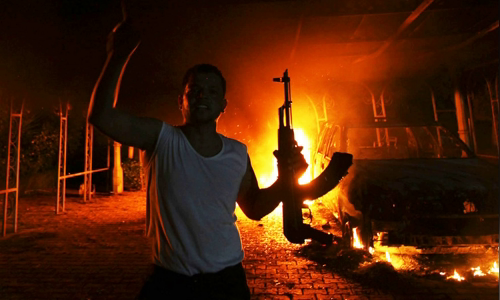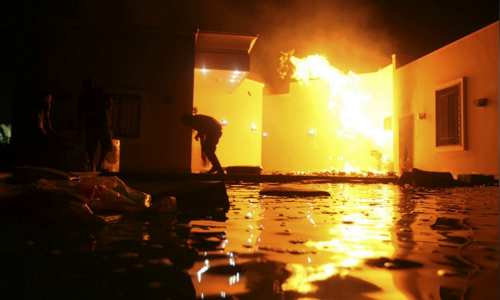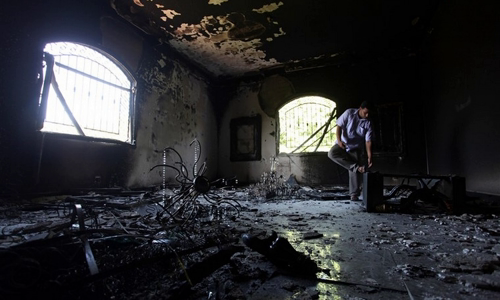Rebels raided the US consulate in Benghazi, Libya in 2012, killing ambassador Christopher Stevens and three people dead.
"Open the gate, bastard," a rebel shouted, and pointed his AK at the guard outside the main gate of the US consulate in Benghazi, Libya. The Libyan soldier had no choice but to obey the order and open the door, before a series of gunmen flooded the consulate, starting a quick raid at 9:40 pm on September 11, 2012.

A gunman joined the attack on 9/11/2012 Photo: Reuters
The gunmen quickly spread throughout the building and opened the northeastern gate, allowing four cars to carry more rebels inside. A series of pickup trucks carrying 12.7 mm and 14.5 mm machine guns occupy a favorable position in the east and west of the consulate to deal with rescue forces.
A rebel opened fire, while a gunman threw grenades into the building, signs that the attack had begun. An American agent saw rebel groups in, and Libyan guards and local militia fled to preserve their lives.
The agent immediately alerted the US embassy in the capital, Tripoli, and the Quick Response Force (QRF) was stationed at the secret base of the US Central Intelligence Agency (CIA) more than 1.5 km away. "Benghazhi is under attack, terrorist attack," the brief message said.
The then US ambassador to Libya, Christopher Stevens, was in a safe room, the reinforced site deep within the consulate. However, the attackers took only 15 minutes to enter the main building and set fire to the fire.
The testimony of the survivors shows that the rebel group is well-trained. They are divided into small groups, move strategically and use hand signals to communicate with each other.
"The attackers have clear orders and perfect intelligence. They know every location and approach to the ambassador's rest area, as well as how to neutralize security forces and land guards. later that night, "commented Fred Burton of Vanity Fair.

Islamic militants set fire in the US consulate area Photo: Reuters
Ambassador Stevens, liaison officer Sean Smith and a security agent have to leave the room to avoid suffocation. The dense black smoke made the three people get lost. Meanwhile, US and Libyan security personnel were caught between the intense fire and the rebellion's fire, unable to handle the increasingly complex situation.
Agents with Stevens escape the burning building and get help, but can't save Smith. The liaison officer was killed by smoke, while Ambassador Stevens was lost in the dark smoke.
45 minutes after the attack began, US forces tried to retake the main building but were repulsed by strong rebel fire, forcing them to take refuge in a nearby annex. The second offensive attempt took place at 11:20 am and succeeded, the Islamic militants were knocked out of position.
However, the battle was not over when the gun battle turned to the shelter. "Two more US agents were killed and two injured during this period," an unnamed US official said.
US and Libyan security forces regained full control of the consulate only at 2:30 on September 12, more than four hours after the first gunfire was fired. Still, they could not determine the location and status of Ambassador Stevens.
Unbeknownst to the Americans, Ambassador Stevens was found and rescued by a Libyan group from a smoke-filled room unconscious. He was taken to Benghazi Medical Center at 1 o'clock in a private car, because there was no ambulance available at that time.

The consulate building was completely destroyed after the attack Photo: Reuters
Doctor Ziad Abu Zeid underwent an artificial respiration procedure for 90 minutes, before concluding Ambassador Stevens died from smoke inhalation and no other injuries. The body of the American ambassador was later transferred to Benghazi airport and handed over to the US side, before being taken to Ramstein base in Germany and returned home with the bodies of three killed earlier.
A report released by the US House of Representatives in 2013 showed that the support force to evacuate the US consulate staff on the night of September 11, 2012 is not the US or the Libyan government, but the secret unit with former officers under former President Muammar Gaddafi, who was ousted earlier by the US military.
It seems that a CIA officer had contacted this former group of officers, before they dispatched a convoy with strong firepower to bring American diplomats safely to the airport. "Their actions have saved the lives of more than 20 people. In other words, the individuals who have been overthrown by the United States are the only Libyan people who supported American personnel in the attack in Benghazi," the report said. .
"The Libyan government, which was tirelessly carried by the US State Department, as well as the militia tasked with protecting the housing complex, cannot evacuate US citizens who are in danger," the report said. for good.
Although Republicans and Democrats were still arguing over the details of the report, one thing that could not be argued was that US forces near Libya were not deployed to rescue the consulate in Benghazi that night. US military units only appeared in Libya at noon on September 12, more than 13 hours after the attack began, despite orders from President Barack Obama and defense minister Leon Panetta.
"An anti-terrorist group of US marines waits nearly 3 hours in Rota, Spain and changes combat uniforms up to four times. They even discussed whether to bring personal weapons or not. Force. it took nearly 18 hours to hit Libya, "one witness recalled.



 WendyPerez
WendyPerez







